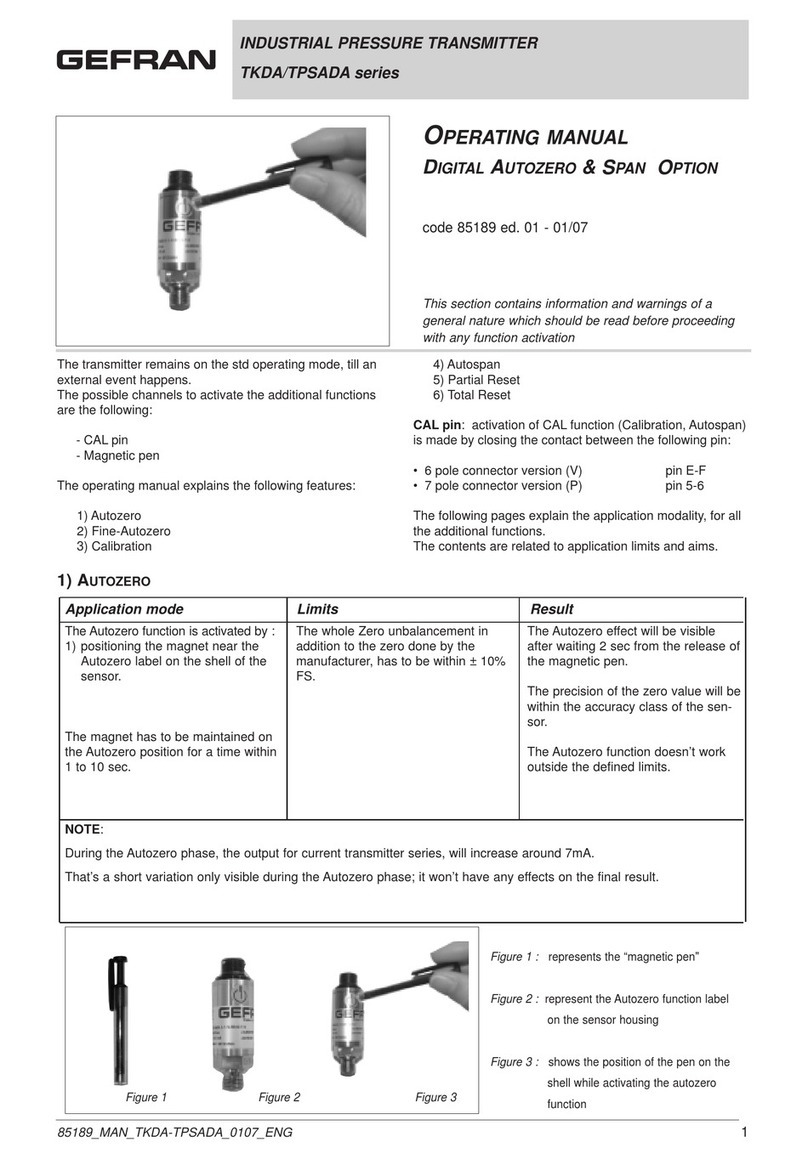
480636B_MAN_HMF - HWF_05-2022_ENG
Gefran Smart HART series READY-TO-USE GUIDE
This Ready-to-Use guide can be used by expert instrumentation operators to configure the transmitter using HART
Communication or Autozero/Calibration features through magnetic pen or contacts on output connector.
For more full information please refer to the complete manual before operating.
The Ready-to-Use procedure with HART is intended for users already familiar with HART Communicator and loop powered
equipment.
READY-TO-USE Using magnetic pen / pin CAL feature
Bring the system to the working temperature with the transmitter installed and connected to the measurement instrument
without any pressure applied. For a 6 or 8 pin connector version, Pin A is Sig+/Exc+ and pin B is Sig-/Exc-.
For conduit output configurations, please look at Electrical Connections chapter.
Assure proper loop feeding voltage is applied to transmitter.
The measurement chain connected to the transmitter is calibrated as follows:
1) Reset the offset on the instrument by eliminating the thermal drift with the Autozero function.
With the sensor installed and the extruder at working temperature, wait until the temperature itself is stable, with a pos-
sible variation of ±1°C. Consequently Autozero can be activated.
This allows to compensate all the signal drifts caused by tightening and temperature. Additional Autozero activations
could be run once the temperature stability is reached, with ±1°C of possible variation.
2) Calibrate the instrument activating the CAL function.
The transducer brings its output to the calibration value shown on the transducer data plate (80% of full scale default,
if changed with HART command it could be different). With the external Autozero function the calibration procedure is
not feasible.
3) If the instrument does not exactly indicate zero, repeat points 1) and 2).
READY-TO-USE Using HART Communicator
Bring the system to the working temperature with the transmitter installed and connected to the measurement instrument
without any pressure applied.
1) ConnectCommunicatortotheloop.Incaseit’snotsureonhowtodothis,pleasereferto“ConnectingtheHART
Handheld Communicator” (Fig. 8.1).
2) Switch on HART Communicator. For reference please refer to HART Command tree on the following page.
3) From the main menu:
a. Enter Tag (Fast Key 1, 3, 1)
b. Set Pressure Units (Fast Key 1, 3, 3), if needed
c. Set URV (Fast Key 1, 3, 4) if output turndown (rescaling), is needed
d. Perform Autozero (Fast Key 1, 2, 6, 3, 1)
4) Check loop output is zero (4mA).
5) Remove HART Communicator from loop.




























